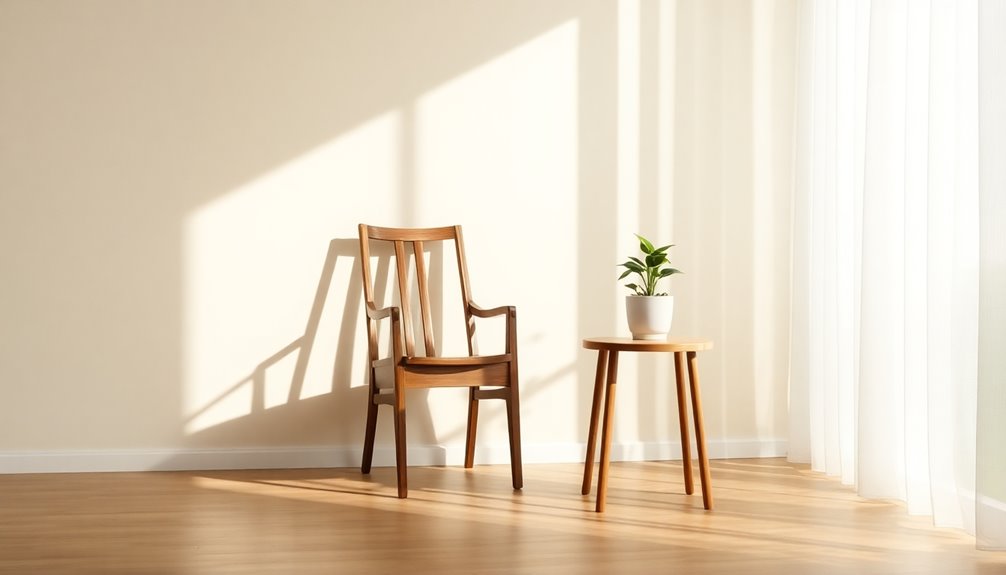Mindful minimalism combines mindfulness with decluttering to help you align your possessions with your core values. It encourages intentional living, reduces distractions, and enhances focus while alleviating stress linked to materialism. By engaging in mindful consumption and being present in your decisions, you can create a serene environment that reflects what truly matters. If you're curious about practical strategies and community support to deepen your practice, there's so much more to explore.
Key Takeaways
- Mindful minimalism merges mindfulness and decluttering, focusing on intentional choices that align with personal values and aspirations.
- Decluttering involves evaluating emotional attachments and releasing items that no longer serve a purpose in one's life.
- Mindful consumption encourages assessing the necessity of purchases, fostering gratitude for chosen possessions.
- Incorporating mindfulness practices, like deep breathing, can enhance focus and reduce stress during the decluttering process.
- Online communities and resources provide support and strategies for maintaining a mindful minimalist lifestyle.
Defining Mindful Minimalism
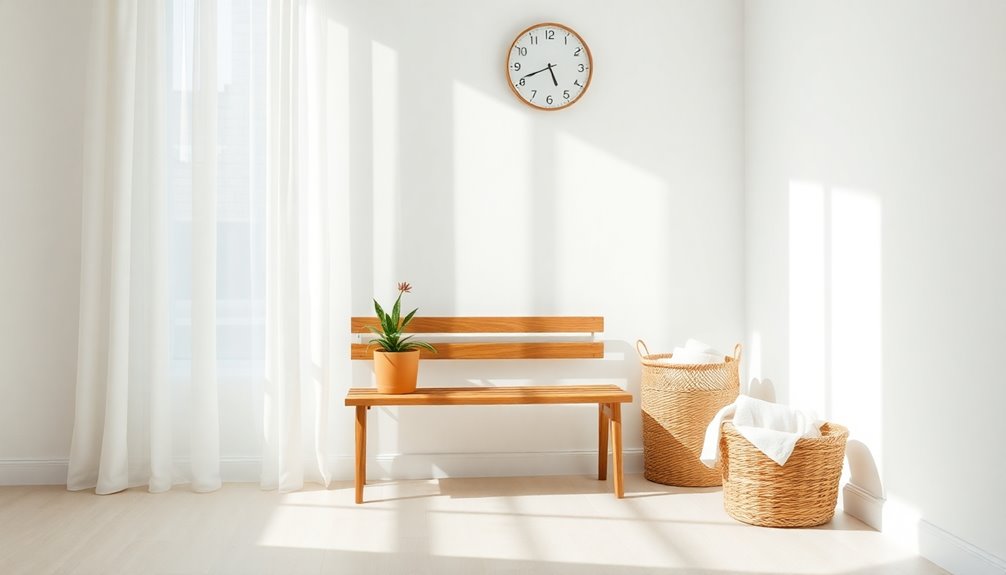
Mindful minimalism combines the simplicity of minimalism with the awareness of mindfulness, creating a lifestyle that encourages you to assess what truly matters.
This approach merges the goal of reducing excess possessions with being present in your daily activities. By practicing mindful minimalism, you intentionally choose what to keep in your life, aligning your possessions with your personal values and aspirations.
Mindful minimalism encourages intentional choices, aligning your possessions with your values while fostering presence in everyday life.
You'll find that decluttering your physical space often results in enhanced mental clarity and reduced distractions. Embracing a non-judgmental attitude towards both your belongings and feelings allows you to let go of attachments, fostering simplicity.
Ultimately, mindful minimalism serves as a pathway for personal growth and self-discovery, making your life more intentional and fulfilling.
The Benefits of Mindful Minimalism
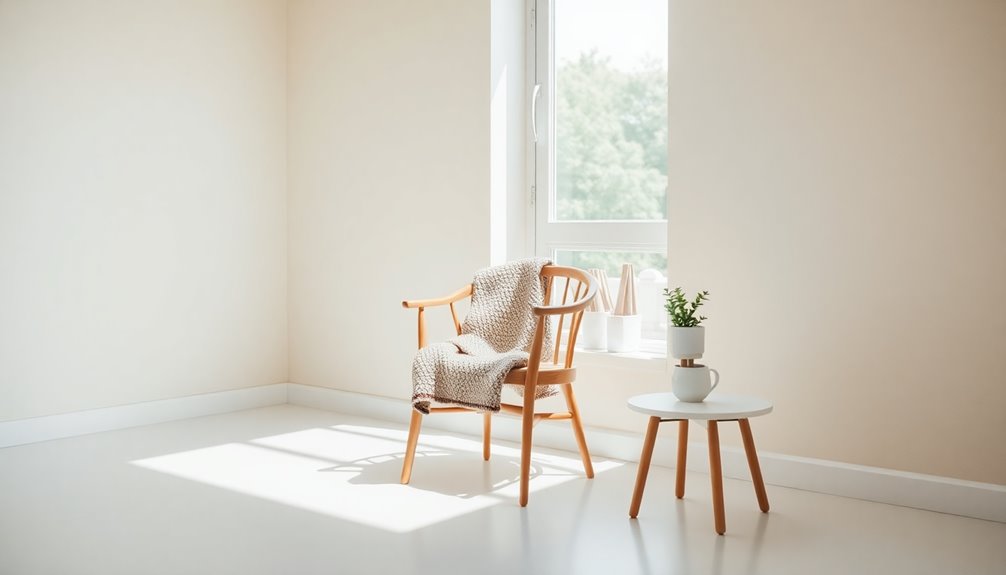
Mindful minimalism offers you the chance to live more ethically while enhancing your focus and clarity.
By simplifying your surroundings and choices, you can reduce distractions and make more intentional decisions that align with your values.
This practice not only sharpens your mental clarity but also encourages responsible consumption that positively impacts the environment. Additionally, embracing the elegance of simplicity allows you to appreciate the beauty in your life and surroundings, fostering a deeper connection to what truly matters.
Ethical Living Advantages
Although many people feel pressured to consume more, embracing mindful minimalism offers a revitalizing approach to ethical living.
By prioritizing quality over quantity, you can enjoy several ethical living advantages:
- Sustainable purchasing: Choose items that benefit the environment.
- Reduced waste: Lower your impact on landfills and natural resources.
- Deeper connections: Foster gratitude for possessions that truly add value.
- Enhanced mental well-being: Alleviate stress and anxiety linked to materialism.
- Alignment with values: Promote responsibility and mindfulness in your consumer choices.
Adopting mindful minimalism not only transforms your lifestyle but also cultivates a sense of purpose, allowing you to make conscious decisions that resonate with your values. Simplifying commitments reduces stress and enhances focus, further enriching your mindful minimalism journey.
Enhanced Focus and Clarity
Embracing mindful minimalism not only enhances your ethical living but also sharpens your focus and clarity.
By intentionally decluttering, you reduce distractions, allowing you to concentrate on what truly matters. Studies show that a simplified environment leads to decreased stress and improved mental clarity.
When you practice mindfulness alongside minimalism, you cultivate self-awareness, helping you prioritize tasks and make better decisions, which boosts productivity. A clutter-free space enhances cognitive function, promoting problem-solving and creative thinking.
Regularly evaluating your belongings and commitments encourages you to refine your focus, aligning your actions with your personal values. Additionally, maintaining emotional regulation is crucial, as it supports better decision-making and coping strategies in the face of distractions.
Key Principles of Minimalism and Mindfulness
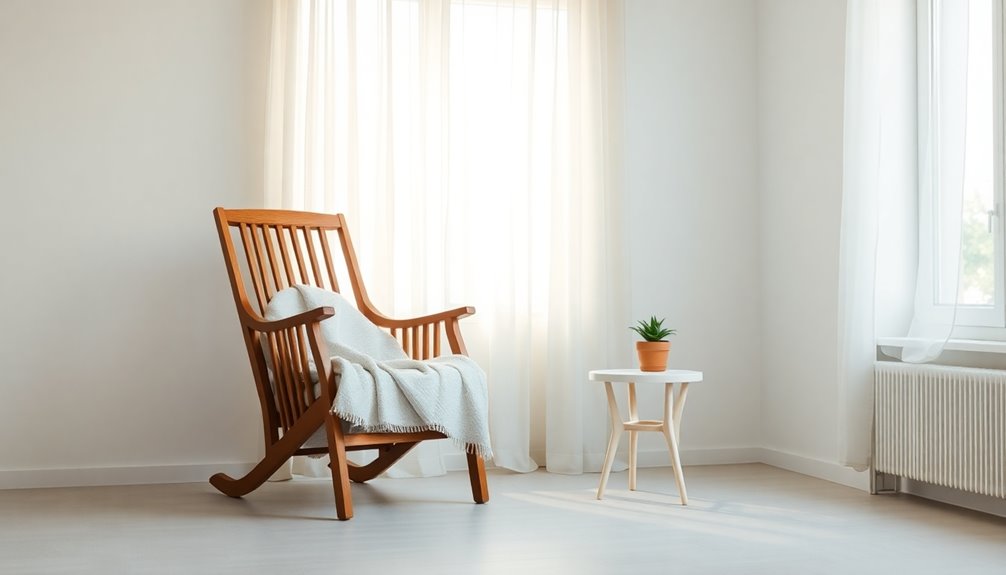
When you embrace mindful minimalism, you intentionally strip away distractions to focus on what truly matters. This combination not only enhances your awareness but also brings clarity and peace to your life. Additionally, practicing mindful decluttering strategies can help you maintain a more organized and fulfilling environment.
Defining Mindful Minimalism
Mindful minimalism blends the intentional simplicity of minimalism with the present-moment awareness of mindfulness, creating a holistic approach to living.
This practice encourages you to embrace a lifestyle that prioritizes clarity and purpose.
Here are some key principles of mindful minimalism:
- Intentionality: Evaluate what truly matters to you.
- Present-Moment Awareness: Focus on your current thoughts and feelings.
- Decluttering: Remove physical and mental distractions.
- Mindful Consumption: Assess the necessity of your purchases.
- Emotional Clarity: Recognize and release attachments to possessions.
Benefits of Combining Practices
Practicing mindful minimalism offers numerous benefits that can transform your everyday life. By combining these practices, you prioritize intentionality, reducing distractions and enhancing focus on what truly matters.
This approach not only helps you declutter physically but also promotes mental clarity, improving your emotional well-being and lowering stress levels. Engaging in mindful practices while decluttering fosters self-awareness and reflection, deepening your understanding of personal values and priorities.
You'll develop a non-judgmental attitude toward your possessions, making it easier to let go of attachments and embrace a more fulfilling life. Research shows that those who practice mindful minimalism often experience higher levels of life satisfaction and contentment, as they align their possessions with their values and live more purposefully. Additionally, incorporating effective relaxation techniques can further enhance your ability to manage stress during the decluttering process.
Strategies for Decluttering Mindfully

As you commence on the journey of decluttering, reflecting on the purpose and value of each item can greatly enhance your decision-making process.
Reflect on each item's purpose and value to enrich your decluttering journey and bolster your decision-making.
Practicing mindfulness during this process allows you to focus on what truly matters. Here are some strategies to declutter mindfully:
- Set aside a few minutes daily for a small area.
- Use the "one in, one out" rule to maintain balance.
- Approach each item with a non-judgmental mindset.
- Acknowledge emotional attachments but allow release.
- Incorporate mindfulness techniques like deep breathing or meditation before you start.
Mindfulness Practices to Enhance Minimalism
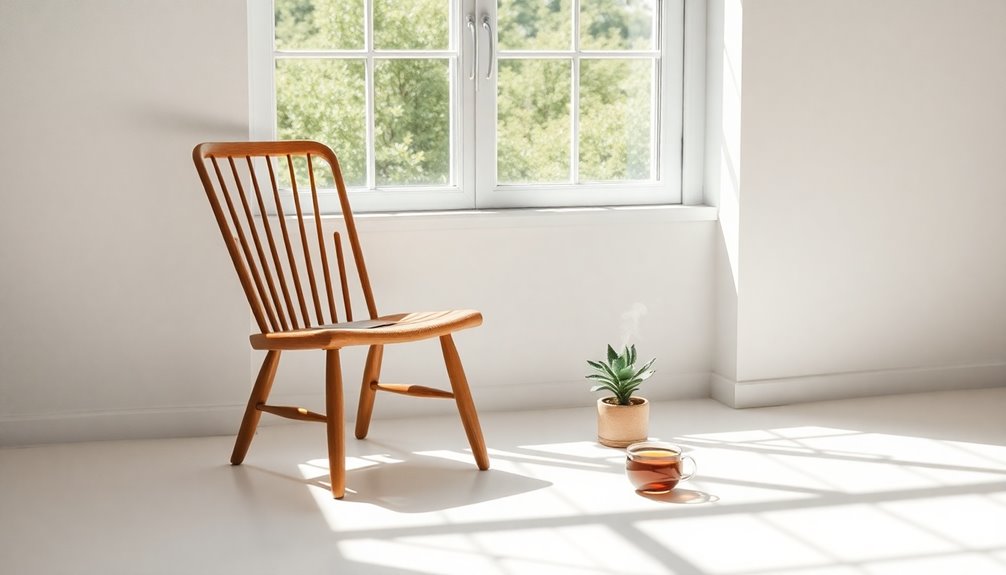
To enhance your minimalist journey, consider adopting mindful consumption habits and viewing cleaning as a form of meditation.
By being present during these practices, you can cultivate a deeper appreciation for what you truly need and enjoy.
This approach not only simplifies your space but also enriches your overall experience of minimalism.
Mindful Consumption Habits
While you navigate the journey of minimalism, adopting mindful consumption habits can profoundly transform your relationship with belongings. By evaluating your purchases, you focus on items that truly matter.
Here are some strategies to enhance your mindful consumption:
- Reflect on the necessity of each item before buying.
- Identify emotional triggers that lead to impulse buying.
- Implement a "one in, one out" rule to maintain balance.
- Keep a shopping journal to track your spending habits.
- Embrace appreciation for the items you choose to keep.
These practices not only reduce clutter but also foster intentional decision-making. Additionally, being aware of your budgeting practices can help you make more informed purchasing decisions, aligning your spending with your financial goals.
Cleaning as Meditation
Cleaning can be more than just a chore; it can become a form of meditation that grounds you in the present moment. By engaging in mindful cleaning, you focus on the sensations of each task—whether it's wiping surfaces or organizing belongings. This practice encourages gratitude for your possessions and allows for introspection.
| Technique | Benefits | Mindful Approach |
|---|---|---|
| Washing dishes after use | Promotes cleanliness | Cultivates presence |
| Designating spaces | Reduces clutter | Enhances mental clarity |
| Gentle cleaning | Acknowledges imperfections | Fosters self-compassion |
Eliminating distractions makes cleaning a mindful experience, helping you create a serene environment while enhancing your mental clarity. Additionally, maintaining a clean space can improve your air quality, which is essential for overall well-being and optimal air quality.
Overcoming Challenges in Mindful Minimalism

Although the journey toward mindful minimalism can be rewarding, it often comes with its share of challenges. You may struggle with letting go of possessions due to emotional attachments and societal norms.
The path to mindful minimalism is fulfilling yet fraught with challenges like emotional attachments and societal expectations.
Information overload can lead to overwhelm, making decluttering hard. Social pressures might encourage accumulation rather than reduction, but connecting with a supportive community can help.
Here are some strategies to overcome these challenges:
- Practice self-compassion during setbacks.
- Set limits on digital consumption.
- Embrace a growth mindset to view challenges as learning opportunities.
- Seek support from like-minded individuals.
- Commit to intentional practice in breaking old habits.
Additionally, recognizing the importance of self-care in empowerment can help you stay focused and motivated throughout your decluttering journey.
Real-Life Examples of Mindful Minimalism
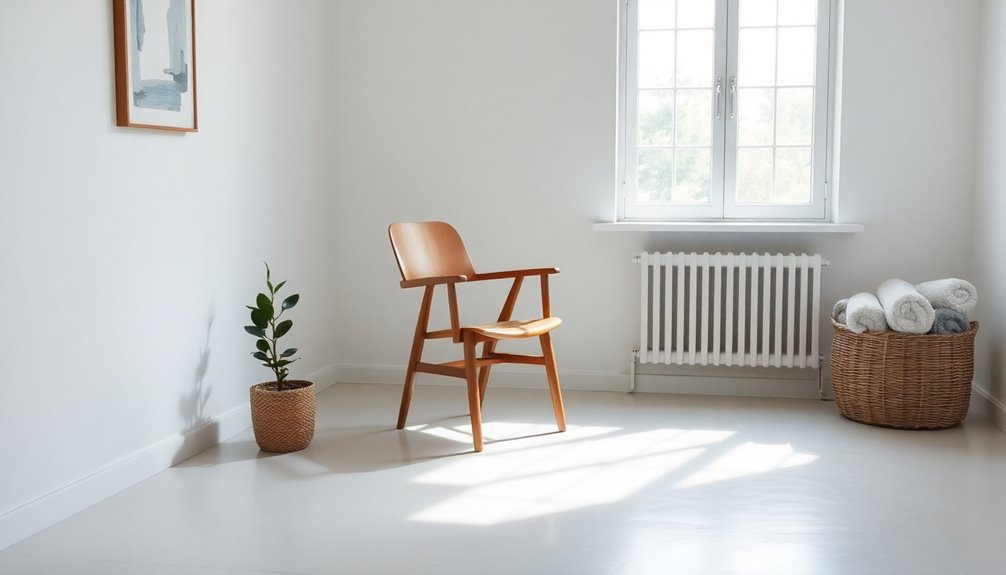
As you explore the concept of mindful minimalism, real-life examples can inspire and motivate you on your journey. Many individuals report significant benefits after decluttering, such as reduced stress and improved focus. Here are some key outcomes:
| Real-Life Examples | Important Things | Benefits |
|---|---|---|
| Decluttered living spaces | Stress reduction | 30% decrease in stress levels |
| Minimalist wardrobe (capsule) | Time saved | 40 minutes gained each week |
| Reduced possessions by 50% | Quality family time | Stronger bonds and increased happiness |
These examples illustrate how mindful minimalism can lead to a more intentional lifestyle, allowing you to focus on what truly matters. Embracing these practices can transform your life in meaningful ways. Furthermore, integrating holistic approaches to health can enhance your overall sense of well-being.
Creating a Mindful Cleaning Routine
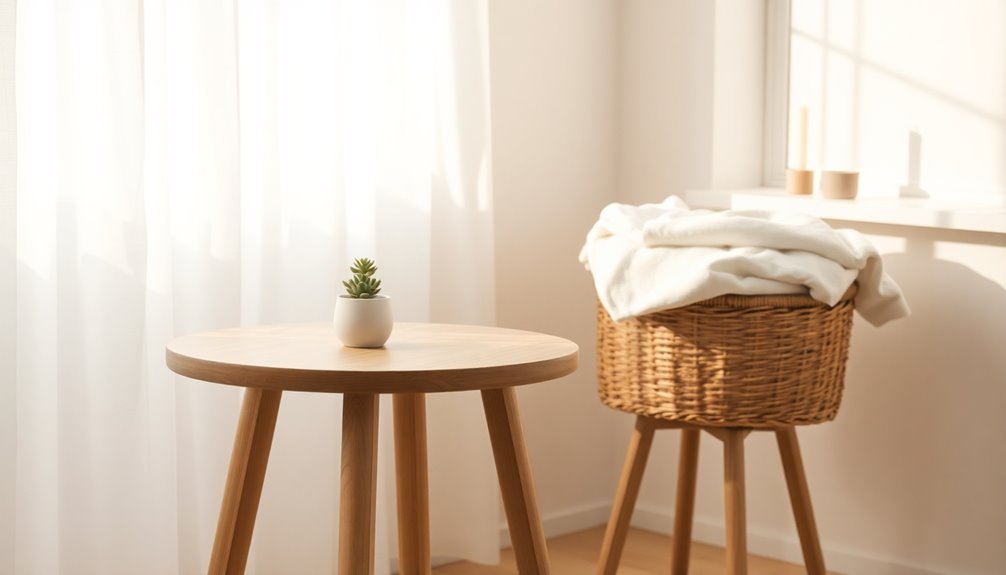
When you approach your cleaning tasks with mindfulness, you can transform what often feels like a chore into a meaningful practice.
By being present, you'll notice your physical sensations, thoughts, and breath, enhancing your overall experience.
Here are some tips for creating a mindful cleaning routine:
- Practice gratitude: Appreciate the function of your belongings.
- Designate spaces: Assign homes for all items to reduce clutter.
- Clean immediately: Tidy up right after use to prevent mess accumulation.
- Reflect during cleaning: Use this time for self-awareness and mental clarity.
- View it as self-care: Recognize cleaning as an opportunity for emotional well-being.
Incorporating these mindful habits can make your cleaning routine more enjoyable and fulfilling.
The Role of Intentionality in Minimalism
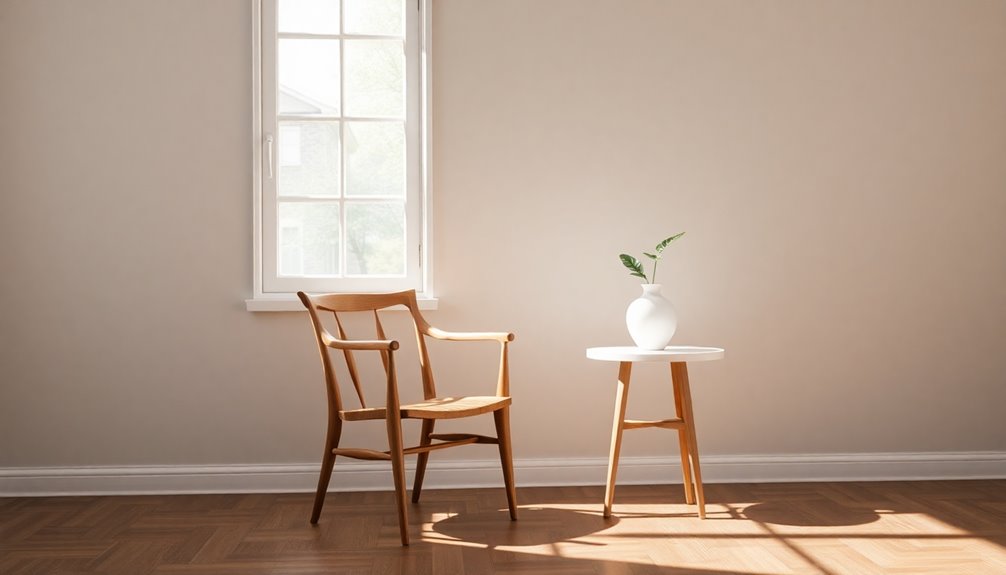
Intentionality lies at the heart of minimalism, guiding you to thoughtfully evaluate what truly enriches your life. By practicing intentionality in minimalism, you can reflect on your values, helping you decide what to keep or let go. This mindset fosters mindful consumption, as you assess the necessity of potential purchases. Furthermore, it influences how you organize your space, ensuring your environment supports clarity and ease. Incorporating elements of nighttime meditation can enhance your ability to reflect and make intentional decisions regarding your possessions and commitments.
| Aspect | Reflection Questions | Benefits |
|---|---|---|
| Possessions | Does this item add value? | Clutter reduction |
| Activities | Aligned with my priorities? | Enhanced focus |
| Commitments | Is this commitment meaningful? | Increased fulfillment |
| Purchases | Do I truly need this? | Mindful spending |
| Environment | Does this space promote clarity? | Improved well-being |
Resources for Practicing Mindful Minimalism
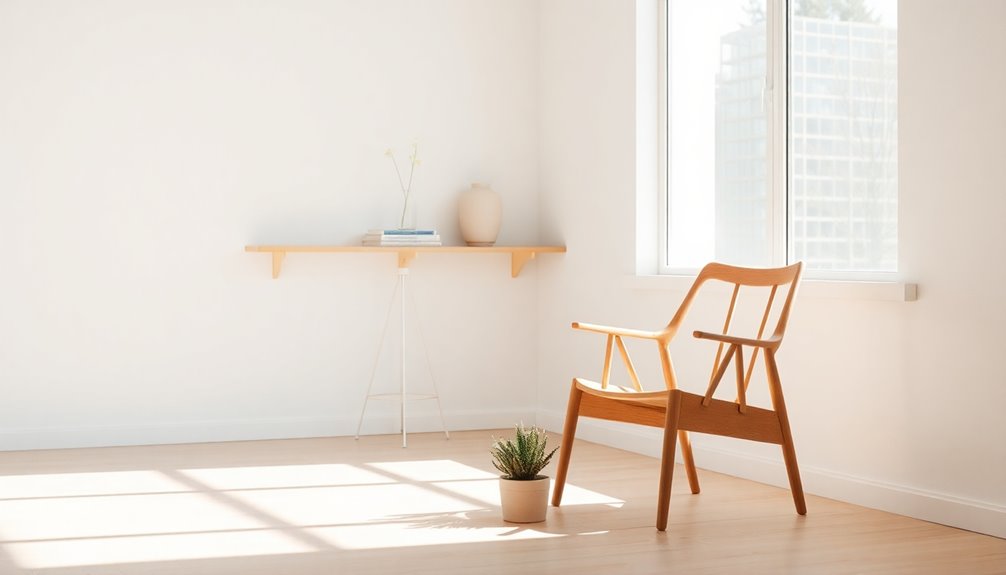
Practicing mindful minimalism becomes easier with the right resources at your fingertips.
To tackle both physical clutter and digital distractions, consider these valuable tools:
- Trimbox: Manage digital clutter by organizing junk mail and emails.
- Mindful Breathing Exercises: Enhance your awareness during decluttering sessions.
- Journaling: Reflect on the emotional impact of items to understand attachments.
- Online Communities: Join forums focused on minimalism for support and shared strategies.
- Books and Guides: Explore literature on mindful minimalism for practical tips and insights.
These resources for practicing mindful minimalism can help you create a more intentional living space, making it easier to stay focused and appreciate what truly matters.
Frequently Asked Questions
What Is the 12-12-12 Rule for Decluttering?
The 12-12-12 rule for decluttering helps you tackle mess by focusing on specific numbers.
You find 12 items to throw away, 12 to donate, and 12 to return to their proper places. This method makes decluttering feel manageable and less intimidating.
What Is the Minimalist Decluttering Method?
The minimalist decluttering method helps you intentionally reduce your possessions to create a more meaningful living space.
You assess each item by asking if it adds value to your life, leading to thoughtful choices about what to keep. By implementing strategies like the "one in, one out" rule, you can prevent accumulation.
Focus on specific areas, like closets, to avoid feeling overwhelmed while cultivating gratitude for what you choose to retain.
What Is the 20/20/20 Rule for Decluttering?
Ever find it tough to decide what to keep or toss? The 20/20/20 rule for decluttering makes it easier.
If an item costs less than $20 and you can replace it in 20 minutes, it's often simpler to let it go. This rule helps you focus on more valuable items while minimizing emotional attachments.
What Is the Connection Between Mindfulness and Minimalism?
Mindfulness and minimalism connect through their emphasis on intentional living.
When you practice mindfulness, you become more aware of your surroundings and your choices. This awareness helps you identify what truly matters, leading to a simpler, more focused life.
By reducing distractions and clutter, you create space for clarity and peace.
Both approaches encourage you to let go of excess, allowing you to appreciate the present moment and enhance your overall well-being.
Conclusion
Incorporating mindful minimalism into your life can transform your environment and mindset. As you declutter with intention and practice mindfulness, you'll discover a sense of peace and clarity amidst the chaos. Imagine walking into a calm, organized space that reflects your true values—how freeing would that feel? By embracing this blend of mindfulness and minimalism, you're not just clearing your physical space; you're creating room for joy, purpose, and deeper connections in your life.
